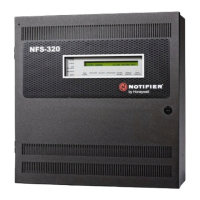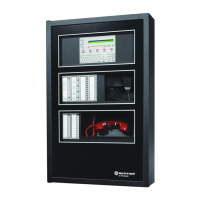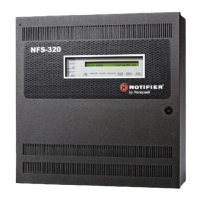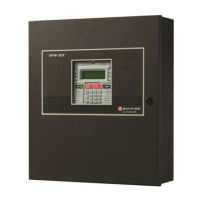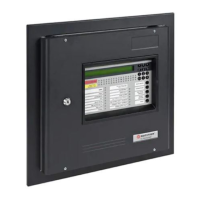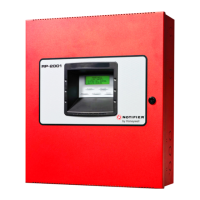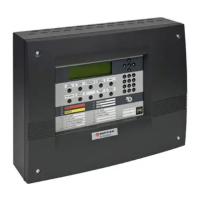28 NFS2-3030 Operations Manual — P/N 52546:A 11/29/2005
Operation of the Control Panel System or Point Trouble Event
POINT TROUBLES
TROUBLE TYPE TROUBLE DESCRIPTION ACTION
AC FAILURE The main or auxiliary power supply has lost AC power. Determine whether there is an AC power loss or whether the
power supply and wiring is correct.
ALIGNMENT MODE A beam detector is in configuration mode. No action is necessary, as the trouble will clear when the
configuration is complete. However, the detector will not detect
a fire while this trouble exists.
BATTERY HIGH The power supply’s battery charge is too high. Check the batteries for problems. Replace batteries if
necessary.
BATTERY LOW The power supply’s battery charge is low, or the RFX
device’s battery charge is low.
Check the batteries for problems. Replace batteries if
necessary.
BEAM BLOCKED Something has come between the detector’s beam and
its reflector.
Investigate and clear the blockage.
BRAND MISMATCH The brand of this SLC device is incompatible with this
FACP system.
Replace with compatible device.
CHARGER FAULT The power supply’s battery charger is not working
properly.
Correct the fault.
DET FAILED TEST This detector has failed the FACP’s periodic detector
test for alarm capabilities.
The detector should be removed and replaced by an
authorized service representative.
DUAL ADDRESS There is more than one device of a single type (detector
or module) with the same SLC address. A detector and
a module can share the same address on an SLC, but
two detectors, or two modules, can not. Note that some
addressable devices (e.g. certain power supplies,
XPIQs and RFXs) may not appear to be detectors or
modules, but are addressed on the SLC as such.
Readdress the incorrect device.
GENERAL TROUBLE The power supply is not working properly. Check the battery for problems. Replace battery if necessary.
GROUND FAULT There is a ground fault on the main or auxiliary power
supply.
Correct the fault.
INITIALIZATION MODE A beam detector is running through its initialization
sequence.
The detector will not detect a fire until the initialization process
is complete and this trouble has cleared.
INVALID RESPONSE The device has returned a response to the panel that
the panel did not expect.
Check the device for functionality, addressing and wiring.
LOW TEMPERATURE The temperature read by a Heat+ or Acclimate™+
detector is too low.
Raise the heat in the area of the detector.
LOW THRESHOLD The detector chamber reading is too low; the detector is
not operating properly.
The detector must be removed and replaced by an authorized
service representative.
MAINTENANCE REQ The detector is dirty and needs cleaning Clean the detector.
MAINT URGENT The detector requires cleaning immediately. It is a false
alarm risk.
Clean the detector immediately.
MISMAT HDWE TYPE The programming information in the panel’s database
for this device does not match the type of device at the
address specified.
Correct programming.
MOD EXT PWR LOSS The control module point has lost external power. Determine whether there is a DC power loss.
NO ANSWER The device (module or detector) is not responding to the
poll. Either the device is not working or it is not
connected properly.
Determine whether the device is functional, and connected
and addressed properly on the SLC.
NORMAL Indicates activated monitor module set to monitor
trouble condition.
Correct trouble condition.
OPEN CIRCUIT The module device has an open circuit on its supervised
wiring.
Check the connections from the module to the input or output
device to which it is wired.
OPEN ON x
There is an open on speaker circuit x Locate and fix the open.
RFX COMM LOSS Communication has been lost with an RFX device Check the RFX to determine the problem.
SECURITY TAMPER An RFX device has been removed from its base. Check the RFX device for tampering.
SHORT CIRCUIT The module device has a short circuit on its supervised
wiring.
Check the connections from the module to the input or output
device to which it is wired.
SHORT ON x
There is a short on DAA speaker circuit x. Locate and fix the short.
VERIFY OVER MAX This detector or FZM-1 monitor module, which has
been programmed to participate in alarm verification,
has gone into and come out of its programmed
verification limit without going into alarm. Either
something is wrong with the detector or there is a
condition nearby (such as someone smoking) that
causes it to go into verification frequently.
Check the detector and the conditions nearby to determine the
problem.
Table 2.1 Point (Device) Troubles

